Abstract
The article is devoted to the issues of assessing the prospects for the development of horticultural non-profit associations of citizens. Including the identification of opportunities for increasing the production of vegetables in this category, agricultural producers met the needs of their families and organized sale of the available surplus of certain types of these products. To conduct a study of Irkutsk State Agrarian University named after Ezhevsky within the framework of the scientific laboratory "Economic Research" on the basis of the Department of Economics of the agro-industrial complex, a methodological approach was developed to assess the prospects for the production of vegetables in horticultural non-profit associations of citizens. As a tool for conducting research, the team of authors developed a questionnaire for interviewing members of horticultural non-profit associations. In the process of processing the results of the questionnaire, problems were identified that hinder the growth of vegetable production in this category of agricultural producers. The main ones are the insufficient support of gardening partnerships from the authorities, the low quality of seed material, zoned to the climatic conditions of the region, and difficulties in selling surplus products. At the final stage of our study, recommendations have been developed aimed at increasing the production of vegetables in gardening associations. The article can be useful for authorities at all levels when developing support programs for this category of agricultural producers. The methodological approach has been tested on materials from the Irkutsk region and can be used in other regions.
Keywords:
Introduction
Currently, in Russia 60 million people are members of horticultural and horticultural non-profit partnerships (hereinafter referred to as summer residents), which conduct their economic activities on 25 million summer cottages. Summer residents on their plots produce 60% of vegetables from their total production in Russia.
Problem Statement
Consumption of food products in accordance with rational consumption norms, including vegetables, was addressed by Aizinova (2011, 2014); Blagovestova (2016); Kurtsev (2013). The state of vegetable growing in Russia and its regions is reflected in the works of Bolshapova et al. (2019); Ivanyo et al. (2018); Okladchik (2019); Ryzhkova (2019), Skulskaya & Shirokova (2010, 2012); Vinokurov et al. (2019). However, the contribution to the production of vegetables by members of horticultural societies in the regions of Russia is poorly studied. Only general issues of the functioning of garden non-profit associations of citizens are touched upon in the works of Gogmachadze (2018); Kalinina et al. (2018); Khomyakov & Seregina (2019); Strepetov (2020); Zaretskikh (2019). Therefore, it becomes necessary to develop a methodological approach to assessing the prospects for vegetable production in horticultural non-profit associations of citizens.
Research Questions
Under these conditions, it is necessary to assess the prospects for the development of horticultural non-profit partnerships of citizens, including the possibility of increasing the production of vegetables in this category of agricultural producers to meet the needs of their families and the organized sale of available surplus of certain types of these products. For this, it is necessary to develop a methodological approach to assessing the prospects for the production of vegetables in horticultural non-profit associations of citizens.
Purpose of the Study
The aim of the study is to develop a methodological approach to assessing the prospects for vegetable production in garden non-profit associations of citizens. To test this methodological approach in the conditions of the region, we draw a conclusion about the possibility of its use in other territories.
Research Methods
The methodological basis of the study is described in Figure 1.
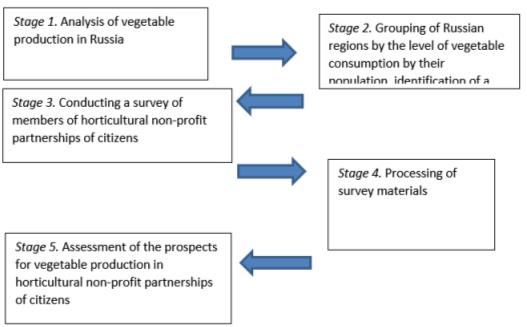
Findings
According to our proposed methodological approach to assessing the prospects for the production of vegetables in horticultural non-profit partnerships of citizens, the first stage is to analyze the production of vegetables in Russia. The volume of vegetable production in Russia during the study period has a steady upward trend. Annual growth averages 1.1%. In 2018, the Russian Federation produced 15655 thousand tons of vegetables, which is 36.8% more than it was in 1990 (Figure 2).
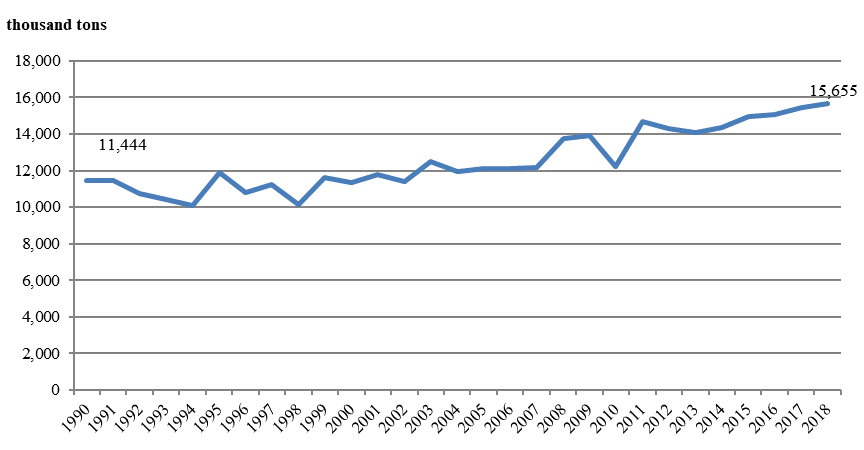
Vegetables are used for industrial and personal consumption. At the same time, industrial consumption accounts for about 7.5%, personal consumption - about 60.5%. In 2018, compared to 1990, the production consumption of vegetables increased 2.4 times and amounted to 1,821.1 thousand tons. In 2018, 15651 thousand tons were used for personal needs of the population, which is 18% more than it was in 1990 (Figure 3).
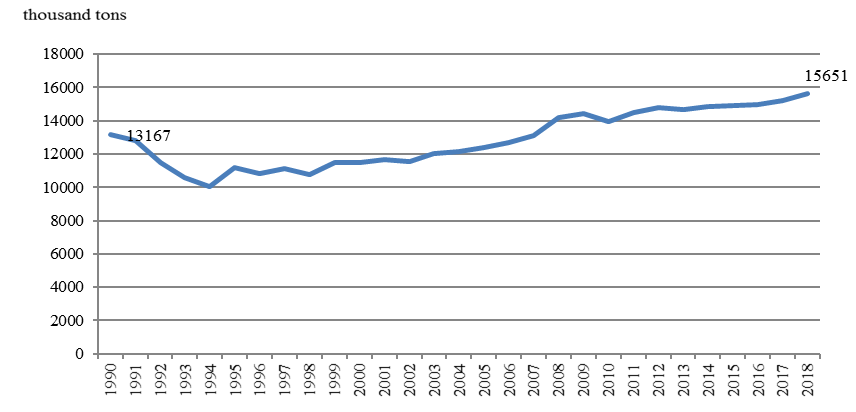
Stage 2. In 2016, new norms of rational consumption of food products were approved in Russia. So, vegetables and melons per capita must be consumed 140 kg per year. In 2018, the average consumption of vegetables per person in Russia was 104.1 kg, which is 25.6% lower than the rational consumption rate. At the same time, the population of only two regions consumed vegetables and melons and gourds above the established norms of rational consumption, this is the city of Sevastopol - 166.6 kg, the Republic of Dagestan - 163.2 kg. Therefore, for further analysis of vegetable consumption, these regions were excluded from the sample.
After grouping the regions according to the consumption of vegetables and melons per capita at equal intervals, it was revealed that the most numerous (i.e. typical) group is the group with the consumption of vegetables per capita from 74.7 to 105.1 kg per year, which included 52 region of Russia (Table 01). On average, the level of consumption of vegetables (including melons and gourds) in this group was 93 kg per person, which is 47 kg below the rational consumption rate. This (typical) group also includes the Irkutsk region.
In 2018, the consumption of vegetables by the population of the Irkutsk region amounted to 86.4 kg per person per year, which is 38.3% less than the rational consumption rate. In the Irkutsk region, in contrast to the average Russian trend, there is a decrease in the volume of vegetable production. So, in 2018, 109.5 thousand tons of vegetables were harvested, which is almost 20% lower than the gross harvest in 2009 (Figure 4).
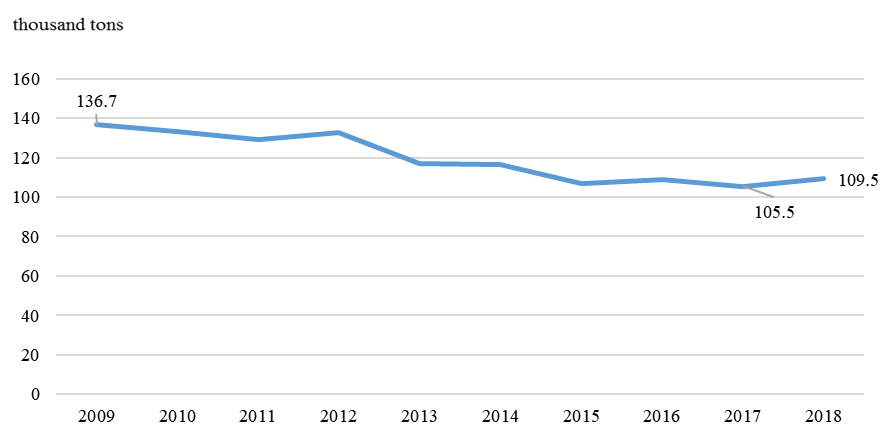
The decrease in the gross harvest of vegetables was mainly due to the reduction in planting areas. In 2018, compared to 2009, the planted area of vegetables decreased by 31.1% and amounted to 4.2 thousand hectares (Figure 5). The greatest decrease in the planted areas of vegetables was observed in agricultural organizations (58.3%), however, the yield of vegetables in this category of farms increased.
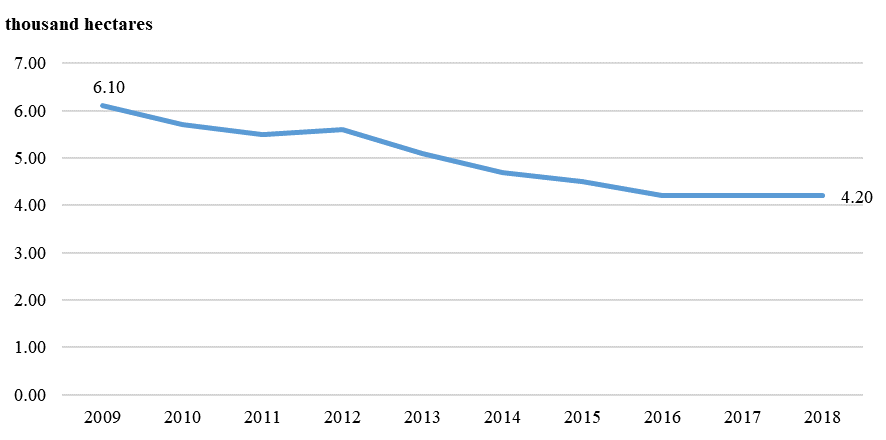
Agricultural organizations produced only 16.7% of vegetables in the region, 69.3% fell to household farms and 14.1% - peasant (farm) households and individual entrepreneurs (Figure 6).
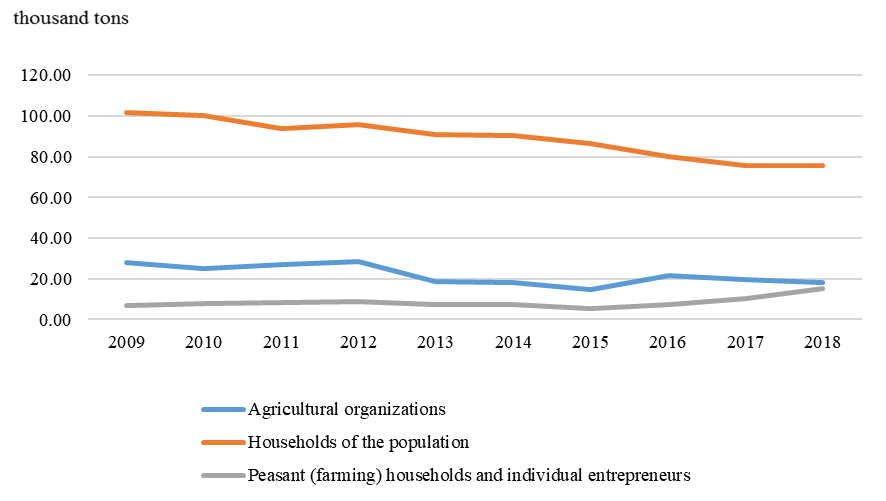
Summer residents make a significant contribution to the production of vegetables in the region and the self-sufficiency of them for their families. In the Irkutsk region, there are about 1.4 thousand horticultural non-profit associations of citizens, uniting more than 70% of the region's inhabitants.
Stage 3. Irkutsk State Agrarian University named after Ezhevsky within the framework of the scientific laboratory "Economic Research" on the basis of the Department of Economics of the agro-industrial complex with the participation of students and postgraduates, according to the methodological approach proposed by the authors, a survey of members of horticultural non-profit associations of citizens was conducted.
Stage 4. The survey made it possible to reveal that the citizens who have summer cottages have an average of 2.37 acres of land per person, including 43.3% of the area is under the planting of garden crops. At the same time, only 95.6% of the respondents are engaged in the cultivation of various horticultural crops.
According to the survey, on average, summer residents grow 63 kg of vegetables per person per season, including cabbage - 9.3 kg, beets - 5.7 kg, carrots - 6.7 kg, cucumbers - 12.7 kg, tomatoes - 13. 5 kg, onions - 4.6 kg, other vegetables - 8.1 kg.
82% of the respondents believe that the vegetables harvested from their garden fully satisfy the needs of their family. However, according to our calculations, our own harvest covers the rational consumption of vegetables by 45.1%, cabbage by 23.6%, beets by 31.5%, carrots by 39.7%, onions by 46.3%, other vegetables by 40.4%.
Summer residents grow cucumbers and tomatoes more than the rational consumption rate by 27.6 and 35.2%, respectively. However, it is worth clarifying that in the Siberian regions, including the Irkutsk region, the main harvest falls on three months (July, August, September). Therefore, the population cannot consume the entire crop when fresh. At the same time, only 8.2% of respondents sell surpluses, the remaining 81.8% of respondents indicated that they do not sell surplus vegetables, because they give them out to relatives or hand them over to the zoo (45%), there are no places and time to sell them (10% each), there is no desire (30%). To preserve vegetables for a long time, 95% of the respondents make preservations for future use.
In the conditions of a sharply continental climate, it is impossible to obtain high yields of some vegetable crops in the open field; therefore summer residents try to install mainly unheated polycarbonate greenhouses on their plots (65.2% of respondents). The average greenhouse area is 29.5 m2 per family.
Most of the respondents use purchased seed. The choice of respondents between purchased and own seed material by types of vegetable crops is shown in Figure 7.
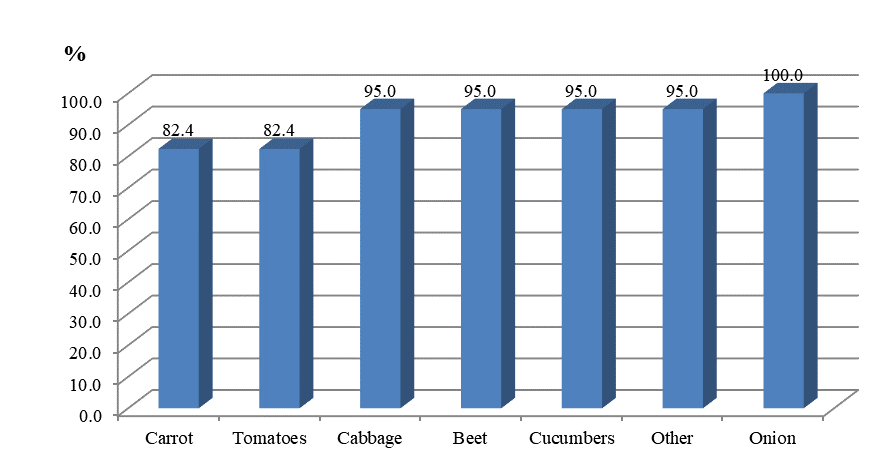
It should be noted that 60% of respondents are not satisfied with the quality of seed material. The quality of carrot seeds (23% of responses) and cabbage (20%) is rated low. The respondents noted low germination (60.9% of responses) and the inconsistency of the grown vegetables with the declared characteristics. None of the respondents have a preference for any one seed producer. The most popular firms are Aelita (13.9% of responses), Partner (11.4%), Siberian Garden (11.4%).
In the Irkutsk region, there are zoned varieties of vegetables approved by the Ministry of Agriculture of the Irkutsk region on the basis of the variety testing work carried out: white cabbage of 13 early-ripening varieties (Gribovskij 147, Iyun'skaya, gibridy Transfer, Parel, Kraft, Adema R3, Ekspress, CHamp, etc.); five mid-ripening varieties, seven mid-late varieties (Belorusskaya 455, Podarok, hybrids Dzhintama i Menzaniya 2018 of 2018).
Eight varieties of red cabbage have been zoned (Mars MS, Mikhnevskaya, etc.), including 18 varieties of cauliflower (the last of them are Charlotte, Talassa and Littoral hybrids from 2014). Cucumbers of zoned varieties and hybrids are 49.
According to the data of the Ministry of Agriculture of the Irkutsk Region, only one variety of tomatoes of 1952, Alpatieva 905A, is zoned for cultivation in open ground. For unheated film greenhouses, 17 hybrids are recommended (Grifon, Al'varo, Piruet, etc.).
Despite the fact that in the Irkutsk region there is a fairly large number of zoned varieties of vegetable crops on sale for the population, they are absent.
Stage 5. The questionnaire survey showed that there are reserves for the production of vegetables in horticultural non-profit partnerships, for this it is necessary to solve the following problems that were identified during the survey of summer residents:
- based on the experience of the Ministry of Rural Irkutsk Oblast, we develop programs to support gardening non-profit associations of citizens, in particular, subsidize the drilling and operation of water wells and assist in the sale of surplus products. The results of the questionnaire indicate that these surpluses exist and should be involved in an organized turnover;
- we tighten control over the quality of seed planting material, zoned to the conditions of the Irkutsk region, which will increase the production of vegetables in orchard plots;
- municipal and regional authorities need to take measures to improve the quality of roads to gardening non-profit partnerships of citizens and adjust the routes of the country buses taking into account the changing needs of summer residents. It is also necessary to assist in the transfer of members of gardening non-profit partnerships to direct payments for electricity consumption with a service provider.
Conclusion
Thus, the methodological approach developed by us was tested in the conditions of the Irkutsk region. Its application makes it possible to assess the possibilities of increasing the production of vegetables, first of all, to meet the needs of one's family, based on the resource potential of the garden plot. The existing insignificant surplus of certain types of vegetable crops can also be involved in an organized turnover, which will increase the consumption of vegetables by the local population, bringing it closer to the established rational consumption rate. This methodological approach can be used by authorities at different levels to develop programs for the development of horticultural non-profit associations of citizens in the Irkutsk region and in other regions of Russia.
Acknowledgments
We express our gratitude to all the gardeners who took part in the survey.
References
Aizinova, I. M. (2011). The underconsumption economy. Studies of Russian Economy Development, 22, 148. DOI:
Aizinova, I. M. (2014). Food consumption in regions of Russia. Studies of Russian Economy Development, 25, 560–572. DOI:
Blagovestova, T. E. (2016). The difference of food consumption in Russia’s regions. Regional Research in Russia, 6, 44–52. DOI:
Bolshapova, N. I., Abramova, I. N., Boyarkin, E. V., & Burlov, S. P. (2019). The current state of potato and vegetable growing in the Irkutsk region. Potatoes and vegetables, 12, 12-14.
Ivanyo, Ya. M., Petrova, S. A., Polkovskaya, M. N., & Fedurina, N. I. (2018). Assessment of risks of agricultural production in areas with a sharply continental climate. Complex systems in extreme conditions. (pp. 95-98.) Federal State Budgetary Scientific Institution "Federal Research Center" Krasnoyarsk Scientific Center of the Siberian Branch of the Russian Academy of Sciences ".
Kalinina, L. A., Kalinin, N. V., Zelenskaya, I. A., & Vlasenko, O. V. (2018). [Problems and prospects for the development of gardening communities in Russia Agro-industrial complex: Economics, management, 12, 25-30.
Khomyakov, D. M., & Gogmachadze, G. D. (2018). Personal subsidiary plots: their role and place in the national agro-industrial complex development project AGROECOINFO, 4(34), 1.
Kurtsev, I. V. (2013). Agricultural aspect of Siberia’s socioeconomic development. Regional Research in Russia, 3, 258–264. DOI:
Okladchik, S. A. (2019). Assessment of the level of development of potato and vegetable growing in the Irkutsk region. Modern problems and prospects for the development of the agro-industrial complex of the region (pp. 462-467). Novosibirsk State Agrarian University "Golden Ear".
Ryzhkova, S. M. (2019). Trends in the development of the cooperative fruit and vegetable market in Russia in the context of sanctions. Fundamental and applied research of the cooperative sector of the economy, 2, 86-96.
Seregina, T. S. (2019). Evolution of organizational and legal forms of associations of citizens in the field of gardening and horticulture. Leningrad legal journal, 2(56), 96-105.
Skulskaya, L. V., & Shirokova, T. K. (2010). Losses of agricultural products and productive resources in the Russian federation. Studies of Russian Economy Development 21, 616–629. DOI:
Skulskaya, L. V., & Shirokova, T. K. (2012). Comparative efficiency of production in separate agricultural sectors. Studies of Russian Economy Development, 23, 371–382. DOI:
Strepetov, V. V. (2020). Foreign experience of participation of non-profit organizations in agricultural legal relations. Issues of Russian and international, 10(1-1), 404-416.
Vinokurov, G. M., Vinokurov, S. I., & Vinokurova, M. V. (2019). [The current state and prospects for the development of regional vegetable growing. Bulletin of higher educational institutions: Economics, finance and production management, 4(42), 71-77.
Zaretskikh, A. A. (2019). Public-private partnership as a co-financing project for the development of the infrastructure of horticultural associations. Problems of modern economic, legal and natural sciences in Russia - synthesis of sciences in the competitive economy (pp. 98-101). Publishing and Printing Center "Scientific Book".
Copyright information

This work is licensed under a Creative Commons Attribution-NonCommercial-NoDerivatives 4.0 International License.
About this article
Publication Date
01 July 2021
Article Doi
eBook ISBN
978-1-80296-112-6
Publisher
European Publisher
Volume
113
Print ISBN (optional)
-
Edition Number
1st Edition
Pages
1-944
Subjects
Land economy, land planning, rural development, resource management, real estates, agricultural policies
Cite this article as:
Kalinina, L. A., Zelenskaya, I. A., Trufanova, S. V., Kalinin, N. V., & Vlasenko, O. V. (2021). Methodological Approach To Assessment Of The Prospects Of Vegetable Production By Citizens. In D. S. Nardin, O. V. Stepanova, & V. V. Kuznetsova (Eds.), Land Economy and Rural Studies Essentials, vol 113. European Proceedings of Social and Behavioural Sciences (pp. 259-267). European Publisher. https://doi.org/10.15405/epsbs.2021.07.32

